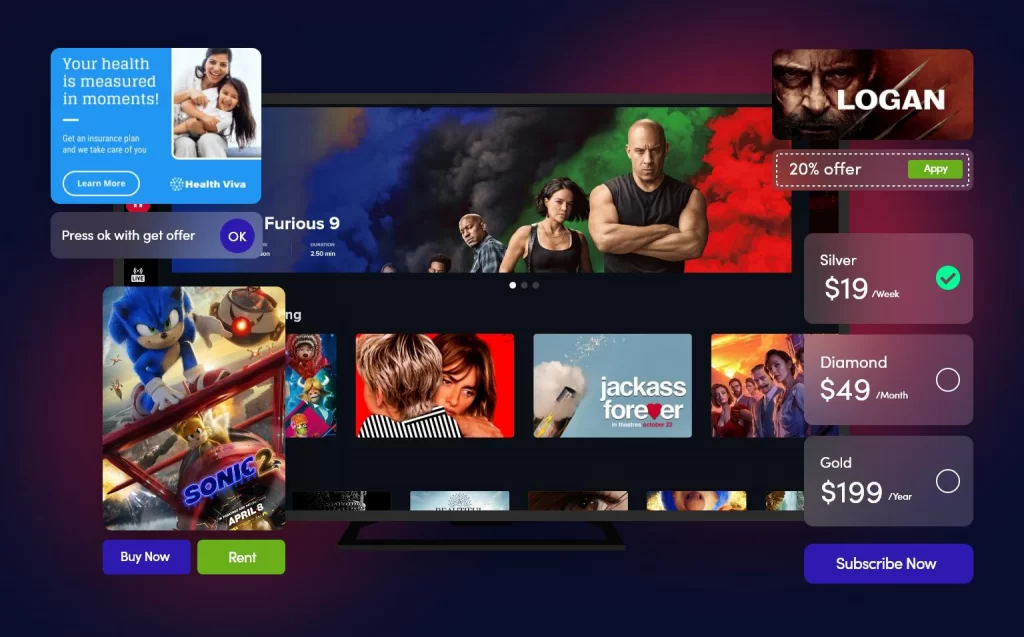Not known Facts About Apollo Group Tv
Not known Facts About Apollo Group Tv
Blog Article
An Unbiased View of Apollo Group Tv
Table of ContentsSome Known Questions About Apollo Group Tv.The 15-Second Trick For Apollo Group TvApollo Group Tv Fundamentals ExplainedThe 3-Minute Rule for Apollo Group Tv
In this circumstance, instead of having three-minute commercial places during a 30-minute television program, television shows may change to one where a consumer will be needed to have a regular monthly subscription, to make sure that they cen view targeted banner advertisements. This kind of marketing currently happens online, and the amount of information tv business collect permits them to do similar.Explain the influence of sponsors on program web content. Define the significant fads among the broadcasting and cable networks. When tv remained in its early stage, manufacturers designed the new medium on radio. Popular radio shows such as authorities dramatization Dragnet and western cowboy collection Gunsmoke were adapted for tv, and brand-new TV shows were funded by solitary marketers, simply as radio shows had actually been.
Today, the television market is much more complex. Programs are sponsored by several marketers; programming is regulated by major media empires; and the three significant networks no longer dominate the airwaves yet rather share their customers with numerous wire networks. Several factors make up these patterns within the market, consisting of technical growths, federal government regulations, and the creation of new networks.
.png)
Not known Facts About Apollo Group Tv
Also public tv has become based on the influence of advertising. Developed in 1969, (PBS) established out of a record by the Carnegie Compensation on Educational Tv, which took a look at the role of instructional, noncommercial television on society. The record recommended that the federal government financing public television in order to offer variety of programs throughout the network eraa service produced "not to market products" yet to "improve citizenship and public service (McCauley, 2003)." Public tv was also planned to offer global access to tv for audiences in backwoods or visitors who can not pay for to spend for personal tv services.
The period between 1950 and 1970 is historically recognized as the. Besides a tiny portion of airtime managed by public tv, the three major networks (understood as the Big 3) controlled the tv industry, collectively representing even more than 95 percent of prime-time watching. In 1986, Rupert Murdoch, the head of multinational company Information Corp, released the Fox network, testing the supremacy of the Big 3.
Targeting young and minority audiences with programs such as Buffy the Vampire Killer, Moesha, Dawson's Creek, and The Wayans Bros., the brand-new networks wanted to draw stations far from their old network associations. Rather than repeating the success of Fox, UPN and WB had a hard time to make an influence. Incapable to bring in many affiliate stations, both recently established networks got to fewer families than their bigger rivals due to the fact that they were impossible in some smaller sized cities.
This choice led the way for the growth of cord motion picture channels, adding to the exponential growth of cord in the 1980s and 1990s. apollo tv. More deregulation of cable in the 1984 Cable Communications Plan Act removed constraints on cable prices, allowing drivers to bill what they wanted for cord services as long as there worked competition to the solution (a criterion that over 90 percent of all cable television markets could meet)
More About Apollo Group Tv

Having developed the first "superstation," Turner broadened his world by founding 24-hour information network CNN in 1980. At the end of the year, 28 nationwide programs services were readily available, and the cable television revolution had started. Over the following years, the sector undertook a duration of rapid growth and popularity, and by 1994 customers can select from 94 fundamental and 20 costs wire services.
Figure 9 - https://myspace.com/apollogtv01.16 Increased competitors from cord networks has caused a steady decline in the networks' audience rankings. During the 1950s, the expense of producing a solitary television program boosted as shows came to be much longer and production prices rose. Sponsorship on network television changed from single sponsorship, in which a program was completely sustained and created by one advertiser, to numerous sponsorship, in which advertisers got 1- or 2-minute spots on the program
Choose one of the Big Four networks and print out its weekly programming schedule. View the network's prime-time programs over the program of a week, noting the target demographic for each show.
The 8-Minute Rule for Apollo Group Tv

Direct television, frequently described as conventional program TV, incorporates cable television and satellite television. It's called "straight" since content complies with a fixed programming schedule, unlike on-demand web content which the private customer determines to see based upon their own preferences and routine. So, when you ask, "What is direct television?", think about it as the timeless means of seeing television that has actually been around for years.
Report this page